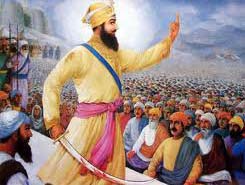| Baisakhi |
 |
Vaisakhi (also known as Baisakhi) is an ancient harvest festival in Punjab, which also marks the beginning of a new solar year and new harvest season. It also has religious significance for Sikhs and Hindus. It falls on the first day of the Vaisakh month in the solar Nanakshahi calendar [It corresponds to April 14 in the Gregorian calendar].
Vaisakhi is one of the most significant and colorful festivals in Sikh calendar, commemorating the establishment of the Khalsa in 1699; which marks the Sikh New Year. It is also observed as the beginning of the New Year in West Bengal, Kerala and some other regions of India. The significance attached to the occasion shows regional variations outside of Punjab. In Himachal Pradesh, Hindu Goddess Jwalamukhi is worshipped on this day; while in Bihar Sun-god Surya is honored. The festival is celebrated as Rongali Bihu in Assam, Naba Barsha in Bengal, Puthandu in Tamil Nadu and Vishu (or Vaishakhi) in Kerala. Besides Punjab, Vaisakhi is widely celebrated as a harvest festival in other northern states of India, such as Haryana, Himachal Pradesh and Uttaranchal.
Vaisakhi in Sikhism
Guru Gobind Singh, the Tenth Guru of the Sikhs founded the Khalsa (Servants of God) at the Vaisakhi gathering in 1699, at Keshgarh Sahib near Anandpur, where he had arranged for followers to meet him at the Vasakhi Fair in Anandpur. On that day Guru Gobind Singh asked for a man to step forward from the congregation, who was willing to die for his cause. One man Daya Ram stepped forward, and followed Guru into his tent. When Guru came out of the tent, his sword was stained with blood; and asked for another volunteer. One by one Dharam Das, Mukham Chand, Himmat Rai and Sahib Chand came forward. One after another they entered Guru's tent, and the Guru emerged alone with his blood stained sword. The crowd was nervous, until five men then emerged from the tent, and were nominated as Panj Piaras or the Guru's chosen ones.
|
 |
The Guru put water in a bowl for sprinkling over the five in a simple initiation ceremony. He said prayers as he stirred the water with a short steel sword; symbolizing the need for strength. The Guru's wife, Mata Sundri, then came forward and placed some sugar crystals into the holy water or amrit as a reminder that strength must always be balanced by sweetness of temperament. After completing his prayers, the Guru then sprinkled the amrit over the five.
|
He declared them to be the first members of an old community of equals, to be called the Khalsa, meaning "pure". These "saint soldiers" were to dedicate their lives to the service of others and the pursuit of justice for people of all faiths. The Panj Pyares were asked to wear five distinctive symbols of their new identity, The Five Ks.
In a move to end social divisions the Panj Pyare's surnames were removed by the Guru, mainly because surnames were associated with one's caste - the Guru then gave them (and all Sikh men) the name Singh, meaning "lion", a reminder of the need for courage. At the same time, the Guru gave all Sikh women the name or title Kaur, meaning "princess", to emphasize dignity and complete equality. The Guru then knelt before the five and asked them to initiate him. Hence, the Khalsa became a community in which master and disciple were equal.
For Sikhs, this seasonal festival also has great importance as the founding of the Akal Khalsa (Soldiers of the Timeless One) at Anandpur Sahib. The Akal Khalsa played an important role in resistance against Mughal rule. For many centuries after that, the first male child of many Hindu families in Punjab was ordained as a Sikh in order for him to train and become a warrior and fight for the people. Other male children used to take care of the family, parents and the land.
Celebrations
The religious remembrance mixed with the remnant of the harvest festivals of Punjab combine to make this an exciting and particularly festive time for all. Celebrations of many different types take place - many Nagar kirtans are arranged in many cities; lots of Langars are held in many Gurdwaras; and holy Paaths are also undertaken where the sacred verses of Sri Guru Granth Sahib are recited. These religious events are combined with Bhangra and other dances.
|
|
|
| Religions |
In India, religion is a way of life. It is an integral part of the entire Indian tradition. For the majority of Indians, religion permeates every aspect of life, from common-place daily chores to education and politics. Secular India is home to Hinduism, Islam, Christianity, Buddhism, Jainism, Sikhism and other innumerable religious traditions. Hinduism is the dominant faith, practised by over 80% of the population. Besides Hindus, Muslims are the most prominent religious group and are an integral part of Indian society. In fact India has the second largest population of Muslims in the world after Indonesia.
|
| Read more about Indian Religions |
|
|
